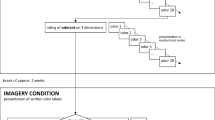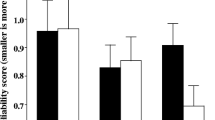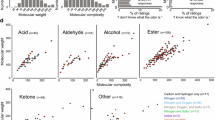Abstract
In a previous series of experiments, the present authors demonstrated that when people are asked to identify the flavors of various drinks on the basis of orthonasal olfactory cues, their judgments are sometimes influenced by the colors of the drinks. Here, we explored the role that expertise plays in mediating color–flavor interactions. Non-experts and flavor experts took part in an odor identification task in which they smelled a number of drinks whose flavors were incongruent with what their colors would suggest. When a particular color, identified by participants as being one that generated a strong flavor expectation, was added to these drinks (as compared to when no such color was added), a significantly greater proportion of both non-expert and flavor expert participants’ identification responses were consistent with this expectation. No significant difference in response behavior was found between these two groups of participants. Using a novel experimental approach that controlled for individual differences, the results of the present study add to the literature showing that flavor experts are not only susceptible to color-induced olfactory biases but perform no differently than non-experts in olfactory identification tasks.



Similar content being viewed by others
Notes
Within this manuscript, the term ‘flavor’ refers to the olfactory component of each drink stimulus. In the experiment reported here participants were asked to provide responses regarding their ‘flavor’ expectations and judgments for the presented drinks, since the term ‘flavor identity’ (as compared to ‘odor identity’) is a more colloquial and well-understood concept among the general population and often refers to the odorant that is added to any drink. This term should not be confused with ‘flavor perception’, which refers to a multisensory process involving multiple senses (see Stevenson 2009, for a review).
Here, we used an individualized approach to assess participants’ color-based expectations about odor identity (see Shankar et al. 2009). In previous research investigating the nature of color–odor interactions (or color–flavor interactions), individual differences have often been overlooked (cf. Davis 1981; Zellner et al. 1992; Zampini, Sanabria, Phillips, & Spence, 2007; Zampini, Wantling, Phillips, & Spence, 2008). One of the methodological improvements in the current experiment is to measure the flavor expectations held by an individual and then to examine whether the very same individual is influenced by his or her specific color-induced expectations. Another improvement present in this experiment is that when analyzing the data for the effects of assimilation, we look for specific patterns of behavior within each individual and only then look for generalized patterns across the whole group (see Cardello 2007).
As decisions regarding what constituted a “low” or “high” discrepancy drink were made by a senior application scientist at Givaudan (personal correspondence, September 10, 2009), a control condition was conducted in order to determine that the selected drinks were in fact perceived as such by our participants.
References
Abdi H (2002) What can cognitive psychology and sensory evaluation learn from each other? Food Qual Prefer 13:445–451
Ballester J, Abdi H, Langloi J, Peyron D, Valentin D (2009) The odor of colors: Can wine experts and non-experts distinguish the odors of white, red, and rosé wines? Chemo Prec. doi:10.1007/s12078-009-9058-0
Cain W (1979) To know with the nose: keys to odor identification. Science 203:467–470
Cardello A (1994) Consumer expectations and their role in food acceptance. In: MacFie HJH, Thomson DMH (eds) Measurement of food preferences. Blackie Academic & Professional, London, pp 253–297
Cardello A (2007) Measuring consumer expectations to improve food product development. In: MacFie HJH (ed) Consumer-led food product development. Woodhead Publishing, Cambridge, pp 223–261
Chollet S, Valentin D (2000) Le degré d’expertise a-t-il une influence sur la perception olfactive? Quelques éléments de réponse dans le domaine du vin [Does the degree of expertise influence olfactory perception? A few elements of the answers in the field of wine]. L’Anne psychologique 100:11–36
Clydesdale F (1984) The influence of colour on sensory perception and food choices. In: Walford J (ed) Developments in food colours—2. Elsevier, London, pp 75–112
Clydesdale F (1993) Color as a factor in food choice. Crit Rev Food Sci Nutr 33:83–101
Clydesdale F, Gover R, Philipsen D, Fugardi C (1992) The effect of color on thirst quenching, sweetness, acceptability and flavor intensity in fruit punch flavored drinks. J Food Qual 15:19–38
Deliza R, MacFie H (1996) The generation of sensory expectation by external cues and its effect on sensory perception and hedonic ratings: A review. J Sens Stud 11:103–128
Desor J, Beauchamp G (1974) The human capacity to transmit olfactory information. Percept Psychophys 16:551–556
Elliot A, Maier M (2007) Color and psychological functioning. Curr Dir Psychol Sci 16:250–254
Engen T, Ross B (1973) Long-term memory of odors with and without verbal descriptions. J Exp Psychol 100:221–227
Garber L, Hyatt E, Starr R (2000) The effect of food color on perceived flavor. J Mark Theory Pract 8:59–72
Garber L, Hyatt E, Starr R (2003) Measuring consumer response to food products. Food Qual Prefer 14:3–15
Gawel R (1997) The use of language by trained and untrained experienced wine tasters. J Sens Stud 12:267–284
Hovland C, Harvey O, Sherif M (1957) Assimilation and contrast effects in reactions to communication and attitude change. J Abnorm Soc Psychol 55:244–252
Hugson A, Boakes R (2001) Perceptual and cognitive aspects of wine expertise. Aust J Psychol 53:103–108
Hutchings J (2003) Expectations and the food industry: The impact of color and appearance. Kluwer: Academic/Plenum Publishers, New York
Lawless H (1984) Flavour description of white wine by “expert” and nonexpert wine consumers. J Food Sci 49:120–123
Pangborn R, Berg H, Hansen B (1963) The influence of color on discrimination of sweetness in dry table wine. Am J Psychol 76:492–495
Parr W, Heatherbell D, White K (2002) Demystifying wine expertise: Olfactory threshold, perceptual skill, and semantic memory in expert and non-expert wine judges. Chem Senses 27:747–755
Parr W, White K, Heatherbell D (2003) The nose knows: Influence of colour on perception of wine aroma. J Wine Res 14:79–101
Rabin M, Cain W (1984) Odor recognition: familiarity, identifiability, and encoding consistency. J Exp Psychol Learning Memory Cogn 10:316–325
Richardson J, Zucco G (1989) Cognition and olfaction: a review. Psychol Bull 105:352–360
Schab F (1991) Odor memory: taking stock. Psychol Bull 109:242–251
Shankar M, Levitan C, Spence C (2010) Grape expectations: the influence of cognitive influences in color–flavor interactions. Conscious Cogn 19:380–390
Shankar M, Simons C, Shiv B, McClure S, Levitan C, Spence C (in press a). An expectations-based approach to explaining the crossmodal influence of color on odor: the influence of the degree of discrepancy. Attention, Perception, & Psychophysics
Shankar M, Simons C, Levitan C, Shiv B, McClure S, Spence C (in press b). An expectations-based approach to explaining the crossmodal influence of color on odor: the influence of spatial and temporal factors. J Sens Stud
Solomon G (1990) Psychology of non-expert and wine expert talk. Am J Psychol 105:495–517
Spence C (2007) Audiovisual multisensory integration. Acoustical Science & Technology 28:61–70
Stevenson RJ (2009) The psychology of flavour. Oxford University Press, Oxford
Teerling A (1992) The colour of taste. Chem Senses 17:886
Wilson T, Klaaren K (1992) Expectation whirls me round: The role of affective expectations on affective experiences. In: Clear MS (ed) Review of personality and social psychology: emotion and social behavior. Sage, Newbury Park, pp 1–31
Yeomans M, Chambers L, Blumenthal H, Blake A (2008) The role of expectancy in sensory and hedonic evaluation: the case of smoked salmon ice-cream. Food Qual Prefer 19:565–573
Zellner D, Durlach P (2002) Effect of color on expected and experienced refreshment, intensity, and liking of drinks. Am J Psychol 116:633–647
Zellner DA, Bartoli AM, Eckard R (1991) Influence of color on odor identification and liking ratings. Am J Psychol 104:547–561
Zellner D, Strickhouser D, Tornow C (2004) Disconfirmed hedonic expectations produce perceptual contrast, not assimilation. Am J Psychol 117:363–388
Author information
Authors and Affiliations
Corresponding author
Rights and permissions
About this article
Cite this article
Shankar, M., Simons, C., Shiv, B. et al. An Expectation-Based Approach to Explaining the Crossmodal Influence of Color on Orthonasal Odor Identification: The Influence of Expertise. Chem. Percept. 3, 167–173 (2010). https://doi.org/10.1007/s12078-010-9072-2
Received:
Accepted:
Published:
Issue Date:
DOI: https://doi.org/10.1007/s12078-010-9072-2




